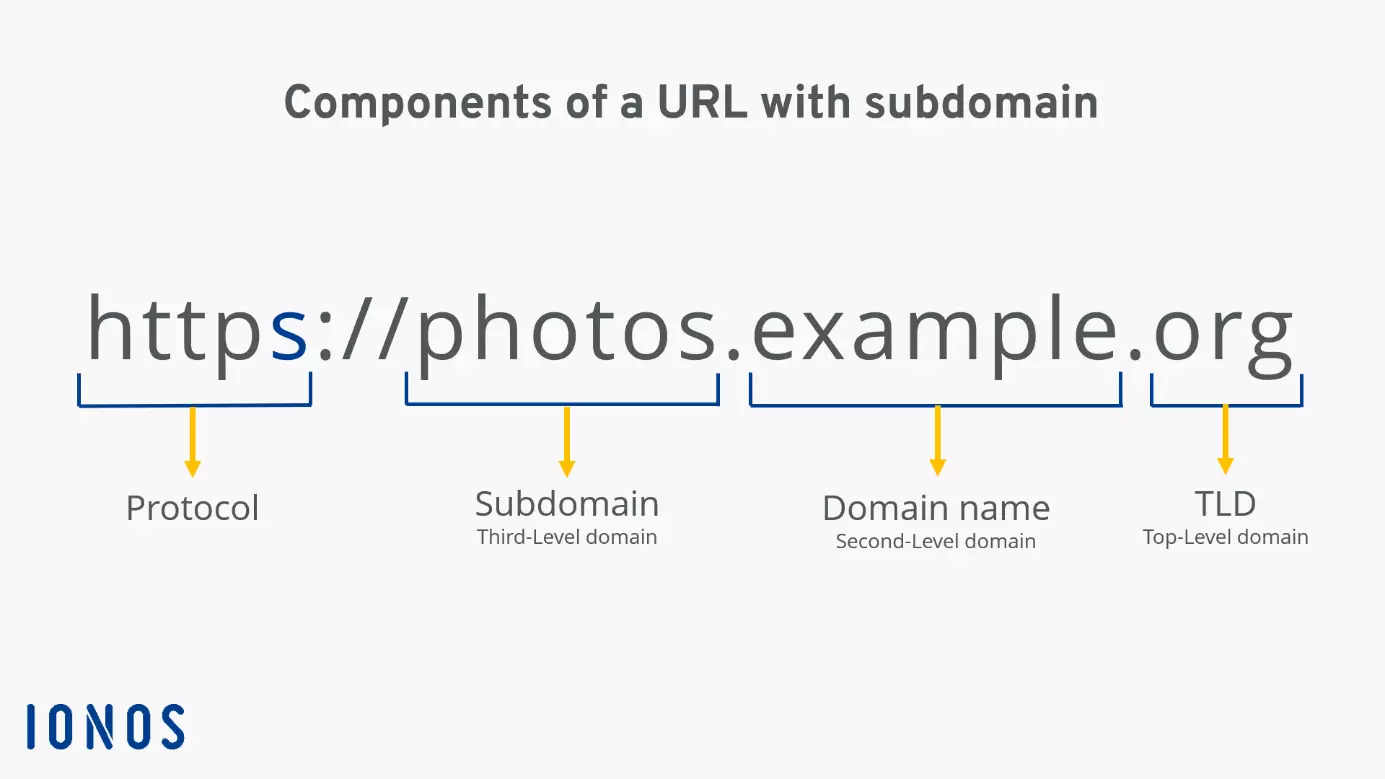What is a subdomain?
All website URLs consist of the transmission protocol (http or https) and a second-level and a top-level domain. In example.org – ‘example’ is the second-level domain (the domain name), while the ‘org’ at the end represents the top-level domain. In addition to these necessary components, a URL can also contain a subdomain. But what is a subdomain?
- Free website protection with SSL Wildcard included
- Free private registration for greater privacy
- Free 2 GB email account
Subdomain: a detailed explainer
A subdomain makes it possible to divide your website into other areas. The name of the subdomain is placed in front of the domain name (top-level domain) and separated from it with a period. The following picture illustrates this:
In the example above, ‘photos’ is the subdomain of the primary domain ‘example’. In this way, website owners could create an independent page with photos from events or other content to differentiate their online presence.
Looking for an alternative to the traditional .co.uk extension, or want to grow your online presence? Give .uk a try today.
£1 for 1 year!
When are subdomains useful?
Now that we’ve established what a subdomain is, the question remains: why should you create a subdomain? The main purpose of using a subdomain is to separate different areas of a website and its contents in a more meaningful way. The different areas are linked by the primary domain name so that users can clearly see that a product, a project, or a location relate to the same company. This not only increases the user-friendliness of the website but is useful for drawing attention to certain topics.
Subdomains are useful for large businesses with multiple locations. For example, if each location is responsible for different tasks and provides different information, it makes sense to create a subdomain for each individual location. In this way, the company can deliver targeted information on a specific location via the respective subdomain.
Other practical areas of application for subdomains are:
- Use of multiple languages: Often, websites that are translated into different languages are separated into subdomains. The English version of our example would be accessible via en.example.org, while the Spanish website would be accessible via es.example.org.
- Mobile version: Instead of responsive layouts many companies also rely on subdomains like m.example.org for a mobile version of their website. In this manner, content for the mobile version can be more easily created and realised using lower data rates.
- Landing pages: To reach potential customers, marketing experts rely on landing pages. These pages are specifically geared towards an offer and optimised to entice new users. The landing pages are usually created as subdomains so that companies don’t have to classify these pages in the hierarchy of the main page. This maintains the relationship to the company, while the marketing team has a lot of leeway in the layout and design of the individual product pages.
- Technical services: Subdomains are also useful for technical services like email (imap.example.org) or FTP servers (ftp.example.org).
How to create a subdomain?
The prerequisite to create a subdomain is a primary domain. Once you have your own domain, you can use the DNS entry to create subdomains. All you have to do is create a DNS entry with the name of the subdomain and forward it to the server that hosts the subdomain. You’ll create subdomains with the provider that manages the DNS settings of your domain. Usually, this will be your web host, but depending on the configuration it can also be your domain registrar.
Don’t have a domain? With IONOS you can register a domain quickly and easily!
Web hosting providers usually simplify the creation of a subdomain by providing helpful tools so that website operators do not have to create DNS entries for subdomains by themselves. In most cases, it is sufficient to specify the desired name and the host creates the entries automatically. The setup process varies depending on the provider.
Already own a domain and want to migrate it to IONOS? No problem! Just use our domain transfer tool.
Relevance of subdomains for SEO
When expanding a website, website operators often wonder whether they should use subdomains, directories, or other domains. But what about SEO for subdomains?
Subdomains are independent domains and, from an SEO perspective, have no connection to the root domain, which is why the primary domain does not transfer its link power and trust to the subdomain. Website operators must therefore optimise subdomains individually for keywords and develop their own link marketing strategy for them. One advantage is that the primary domain and other subdomains are not affected by Google’s algorithmic penalty for the subdomain. The same also applies the other way around.
In addition, usually only one result per domain is shown in search results. Subdomains can be used to place additional adverts and thus achieve more clicks.
